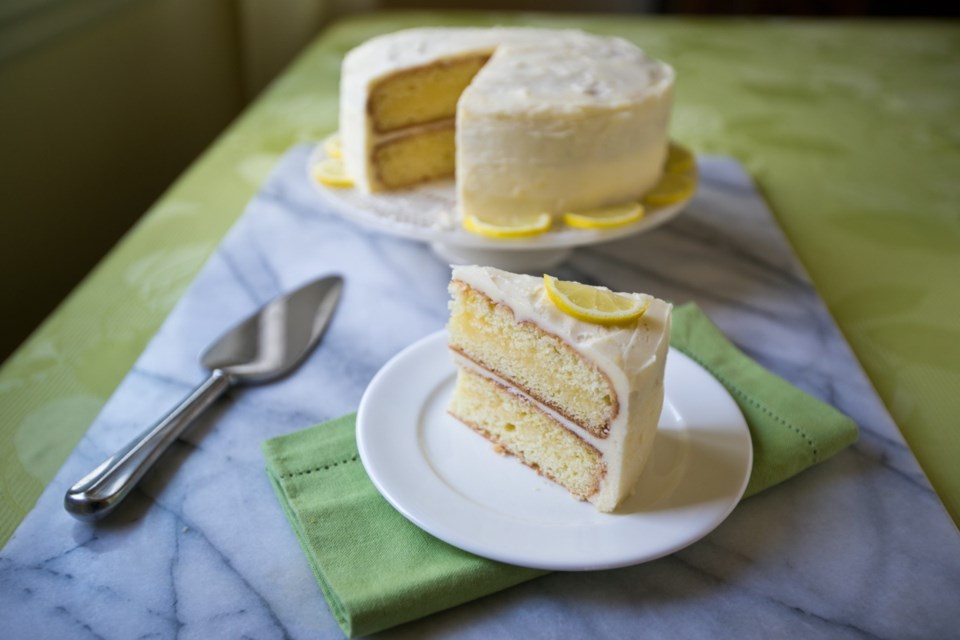 If you like your desserts to be both sweet and tangy, you’ll likely find it hard to resist a slice of lovely lemon layer cake. And if you make it yourself, you’ll take pride in creating a pretty cake just right for a special occasion, such as Easter.
If you like your desserts to be both sweet and tangy, you’ll likely find it hard to resist a slice of lovely lemon layer cake. And if you make it yourself, you’ll take pride in creating a pretty cake just right for a special occasion, such as Easter.
Today’s recipe provides that opportunity.
The process begins by baking two round cakes, which you’ll horizontally cut in half once cooled. I chose to make Victoria-style sponge cake — it’s moist, rich, has a lovely crumb and married well with the lemon zest I flavoured it with. It’s also easy to make.
Beat some eggs, add the cake’s other ingredients and beat until a smooth batter is created, divide batter between two prepared cake pans and bake away. The cakes can be baked a day before you layer and ice them.
The second thing you’ll need to make for the cake is lemon curd, a lemony custard-like mixture. It, too, is not hard to make. Simply combine all ingredients in a small pot, and then cook and stir over moderate heat until thickened.
The curd is then cooled and sandwiched between the cakes when layered. As with the cakes, you could make the curd a day before you layer the cake. Once cooled, keep it covered and refrigerated until needed.
The last component is the icing, which is flavoured with lemon zest and juice. Like the cakes and curd, it’s not hard to make — simply beat all ingredients together until smooth and light.
Do make the icing just before layering the cake, when it’s most spreadable.
You can layer and ice the cake many hours (even the night before) you serve the cake. Refrigerate after doing so and keep the cake cool until ready to serve.
How to ice a cake
These tips will help you ice your cake as neatly as possible. A metal offset spatula, sold at kitchenware stores, is the best tool for icing. Its thin metal blade bends up where it meets the handle. That quality makes it great for icing cakes in finicky spots.
1. Put 2 Tbsp of icing in the centre of your cake plate/stand before setting on the first cake layer. That icing will prevent the cake from sliding when you ice it.
2. Once layered, start icing the cake’s exterior by placing a generous amount — 1 cup or more of the icing on the top of the cake. Don’t hold back, as you’ll spread that icing — around and some will be removed and/or end up on the sides. If you use too little icing at the start, you may scrape the surface of the cake and get crumbs in your icing.
3. Spread and cover the top of the cake with icing, from the centre out just past the edges.
4. Now ice the sides of the cake, adding more icing as needed. Do so in sections, turning the cake plate/stand once that section is iced. The goal at this point is to get the entire cake covered with icing.
5. Once the cake is covered, smooth out the icing as best you can, or create a swirled look if that’s what you prefer. Now chill the cake to set the icing.
Lovely Lemon Layer Cake
Dense and lovely lemon cake layered with tangy lemon curd and lemony icing.
Preparation time: 45 to 60 minutes
Cooking time: About 28 minutes
Makes: 10 to 12 servings
For the lemon curd
1/2 cup granulated sugar
1/2 cup lemon juice
1 large egg
1 large egg yolk
1/2 tsp cornstarch
• pinch salt
For the cakes
• soft butter for greasing
4 large eggs, at room temperature
1 cup extra-fine (berry) sugar (see Note)
1 cup soft butter, cut into 1-inch cubes
1 1/2 cups all-purpose flour
1 Tbsp plus 1 tsp baking powder
1/2 tsp salt
• finely grated zest of 1 lemon
For the icing and to finish cake
1 1/8 cup butter, at room temperature
1 tsp finely grated lemon zest
3 Tbsp lemon juice
3 1/2 cups icing sugar, sifted
• half-moon lemon slices, for garnish (optional)
For the lemon curd
Place all ingredients in a small pot and whisk until thoroughly combined. Set over medium heat and bring to a simmer, stirring frequently. Simmer curd until thickened, about one minute. Remove from the heat and transfer lemon curd to a bowl, ensuring you get all of it. Cool curd to room temperature, cover and refrigerate until needed.
For the cakes
Set an oven rack in the middle position. Preheat the oven to 375 F. Lightly grease two eight-inch (20 cm) round cake tins with butter. Cut a circle of parchment paper to fit the bottom of each pan and set them there.
Place the eggs for the cake in the bowl of your stand mixer fitted with the paddle attachment (see Note). Beat the eggs until well blended.
Add the cakes sugar, butter, flour, baking powder and salt. Beat well until you have a smooth batter with no flecks of butter in it. Evenly divide the batter between the two cake tins and smooth the surface with a spatula.
Bake the cakes in the centre of the oven for 23 to 24 minutes, or until golden and they spring back when very lightly touched in the centre.
Cool the cakes in their pans on a baking rack 20 minutes. Now run a paring knife around the outside of each cake. Carefully unmould each cake onto the baking rack. Now cool the cakes to room temperature.
For the icing and to finish cake
Place the icing’s butter, lemon zest and juice and icing sugar in the bowl of your stand mixer and beat until thoroughly combined and lightened (see Note). Scrap down the sides of the bowl and beat one minute more.
Set one of the cakes on a work surface, hold it in place with the palm of one hand and use your other hand to hold a sharp serrated knife. Use the knife to cut the cake horizontally in half. Now cut the second cake in half.
Place 2 Tbsp of the icing in the centre of your cake plate or stand, and then set on one of the cake halves, cut side up. Spread the top of that cake with half (about _ cup) of the lemon curd, leaving a one-inch border of clean cake around its edges. (The lemon curd will squish out to the edges when the next layer of cake is set in place.)
Top the lemon curd layer of cake with another cake half, this time setting it cut side down. Spread the top of that cake layer with 2/3 cup of the icing, ensuring in this case it does reach the edges of the cake.
Top the icing spread cake layer with another cake half, setting it cut side up. Top and spread that cake layer with the remaining lemon curd, again leaving a one-inch border of clean cake around its edges.
Set on the last half cake, cut side down. Carefully, and as smoothly as you can, spread the rest of icing on the top and sides of the cake. Refrigerate the cake until the icing is set and you’re ready to serve.
Just before serving the cake, if desired, it could be decorated with half-moon lemon slices.
Note: Extra-fine (berry) sugar is sold alongside regular granulated sugar in supermarkets. If you don’t have a stand mixer, you could make the cake batter and icing in a large bowl and use a hand-mixer for mixing.
Eric Akis is the author of The Great Rotisserie Chicken Cookbook (Appetite by Random House). His columns appear in the Life section Wednesday and Sunday.



